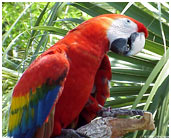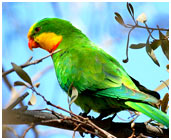Parrots are intelligent birds, inhabiting tropical and subtropical areas. Read on to get some interesting facts and amazing information on parrots.
Facts About Parrot
Parrots are fine-looking birds, mainly found inhabiting tropical and subtropical areas of the world. Grouped into two families, Psittacidae (true parrots) and Cacatuidae (cockatoos), they include as many as 350 species within their order. A parrot can be described as a bird with a strong curved beak, erect carriage, strong legs and clawed zygodactyl feet. Most of its species are green in color, with a few being multi-colored. Parrots are counted amongst the most intelligent birds and are very popular as pets. Given below are a number of interesting facts and some amazing information on parrots.

Facts about Parrot
Binomial Name: Ardea cinerea
Kingdom: Animalia
Phylum: Chordata
Class: Aves
Order: Psittaciformes
Family: Two, Psittacidae (true parrots) and Cacatuidae (cockatoos)
Species: Around 350
Size: 3.5” to 40” (8.7 to 100 cm)
Weight: 0.65 to 1.6 kg
Age: 10 to 75 years (depending on their species)
Diet: Seeds, fruit, buds, nectar and pollen
Natural Habitat: Tropical and subtropical continents
Age of Maturity: 1 to 4 years (depending on their species)
Interesting and Amazing Information on Parrots
- While eating, parrots hold their food in one of their feet, which can be either left or right, making parrots left as well as right handed.
- Parrots, when not nesting, live in groups known as flocks and are prone to squawking and screaming.
- Parrots, mainly pet ones, are very good at mimicking. They can easily imitate the speech and calls of other birds and animals, even humans. African gray parrots are the best mimics.
- Parrots are zygodactyls i.e. they have four toes on each foot. Two of their toes point forward and two point backward.
- Most of the parrots build their nests in holes in trees, termite mounts, rock cavities or ground tunnels. Only a few build stick nests.
- Wild Macaws and Cockatoos can fly up to 500 miles in a day, while searching for food.
- The vocalizations of some parrots can be heard for up to 1 mile.
- Larger parrots can live more than 75 years, while smaller ones live up to 15 years only.
- Parrots cannot eat chocolate because it is poisonous to their body.
- Parrots have a thick muscular tongue that helps them eat fruit, seeds, buds, nectar, and pollen.
- Parrots are omnivorous!
- They are also monogamous, which mean they have only one partner for life.
- Parrots are the only birds, which can pass food to their mouth with their toes.
- Parrots not only use their toes, but their bills for climbing.
- These birds are found in warm climates, almost all over the world.
- The Hyacinth Macaw is the largest parrot, the smallest parrot being the Pacific Parrotlet.
- Parrots need motivation to stay healthy and cheerful. It is bad for them if they are left in the cage alone, with nothing to do. These birds need company.
- In comparison to other pets, like cats and dogs, parrots need more love and care. They are not born to live in cages, but they do! Therefore, they need more affection.
- Parrots like to live in groups and tend to shriek a lot. They are noisy birds.
- Most parrots build their homes in tree holes. They rarely build nests for themselves. Most of them reside in tree holes, rock cavities, ground tunnels and even sometimes in termite dunes.
- One more interesting fact is parrots do not have vocal chords. They have amazing control of their trachea and they produce sound by pushing air out of it. They change the pitch by altering the shape and depth of their trachea.
- Parrots are so colorful, but interestingly their eggs are always white!
- The Sisserou parrot is Dominica’s national bird and is also found on its flag.
- Some 130 species of parrots were declared endangered by the International Union for Conservation of Nature (IUCN).


See also
More from iloveindia.com
- Home Remedies | Ayurveda | Vastu | Yoga | Feng Shui | Tattoos | Fitness | Garden | Nutrition | Parenting | Bikes | Cars | Baby Care | Indian Weddings | Festivals | Party ideas | Horoscope 2015 | Pets | Finance | Figures of Speech | Hotels in India : Delhi | Hyderabad | Chennai | Mumbai | Kolkata | Bangalore | Ahmedabad | Jaipur
- Contact Us Careers Disclaimer Privacy Policy Advertise With Us Lifestyle Sitemap Copyright iloveindia.com. All Rights Reserved.


